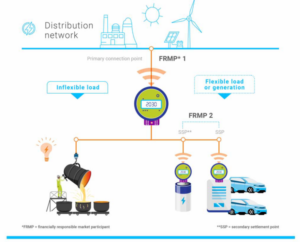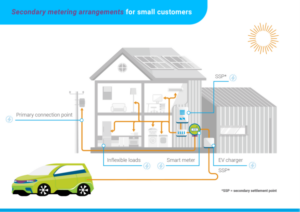Shirley Cheng and Nick Forbutt explain the latest AEMC rules and how they offer a path for consumers and businesses to better control – and benefit from – their energy resources. What does it mean for market participants?
In a significant move to empower energy consumers, the Australian Energy Market Commission (AEMC) has introduced new rules aimed at simplifying the monetization of consumer energy resources (CER). Announced on 15 August 2024, these rules are set to transform how both large and small customers interact with the energy market, providing them with more control over their energy usage and the ability to benefit financially from their energy assets.
This change is not just about reducing bills – it’s a step towards a more efficient and resilient energy grid, where every Australian can play a part in the nation’s energy transition. With these rules, the AEMC is paving the way for a future where energy management is more accessible, cost-effective, and sustainable for all.
Under the new rules, which are set to come into play by November 2026:
- Large customers can establish secondary settlement points (SSPs) behind the primary connection point at their premises, allowing them to engage multiple energy service providers at their premises to manage their flexible CER.
- Small customers will have more options to separately manage ‘flexible’ CER (for example, batteries and EV chargers) from ‘passive’ loads (for example, lighting and fridges) in the energy market.
- New meter types will be introduced allowing for the use of in-built measurement tools to enable more flexible metering arrangements at a lower cost.
These arrangements will be voluntary, with energy service providers and consumers able to take them up when and how they see fit.
In this blog post we share the key takeaways of the rule change, how businesses can benefit and what it means for market participants – from electricity service providers to customers.
- Did you miss it AEMC chair Anna Collyer in conversation with KWM partner Shirley Cheng? Watch it and read key takeaways here. The engaging session, which ran as part of the KWM Digital Future Summit, explored the dual drivers of consumer engagement and innovative technology.
The CER revolution is here
The increased uptake of CER is a key driver of the energy transition, with consumers benefiting from lower energy bills and the grid benefitting from increased reliability from consumers sharing their power and varying their consumption.
Australian households and businesses are increasingly embracing CER, as data in the AEMC’s determination shows:[1]
- Solar: More than three million households and businesses have solar panels, and it is expected that one in every two households will have them by 2040.
- Batteries: More than fifty thousand small-scale battery systems have been installed in the past seven years, and twenty-two million purchases of electric vehicles are expected by 2050.
- Smart devices: People are increasingly using CER in the form of ‘smart devices’ (for example hot water systems) and controlling their use to manage energy consumption through dedicated apps.
- Distributed energy resources: Neighbourhood batteries and VPPs are a growing part of the power system.
The new rules support the National CER Roadmap and the integration of CER into the National Electricity Market (NEM). The rules aim to harness the net benefits of the effective integration and coordination of CER, estimated to be between $1 billion and $6.3 billion by 2030-2040.[2]
Unlocking the value of flexible CER
Large customers
The new rules enable large customers (for example manufacturers and hospitals) to engage multiple energy service providers at their premises, meaning these customers can take up different product and service offers for their CER. Large customers will be able to:
- separate their passive and flexible loads using SSPs
- meter their flexible resources using an in-built meter (and save costs by avoiding a separate metering installation), and
- derive value from their flexible resources through wholesale and ancillary services markets.[3]
The arrangements also establish a less complex framework to enable a second National Meter Identifier (NMI) compared to the embedded network framework.[4]
Flexible trading at large customer premises with multiple energy service providers

AEMC, Final Determination, Figure 3.1.
The AEMC created a new accredited ‘NMI service provider role’ responsible for creating NMIs at SSPs and maintaining the relevant standing data.[5] It is likely that metering coordinators and embedded network managers will perform this role as it is a relatively discrete and technical function.
Small customers
By allowing for SSPs at small customer premises, the final rules enable ‘flexible’ CER loads (such as EV chargers and batteries) to be separately metered and visible in the energy market from ‘passive’ consumer loads (such as lights and fridges). The ability to separately meter and manage flexible loads will enhance consumer benefit from CER and optimise the value of CER for the market and networks.
As a result of the rules, retailers could offer consumers EV charger products that have in-built measurement capability and a dedicated tariff so that the energy flowing through the EV charger is visible and can be traded in the wholesale market. This will allow retailers to extract more value from the EV charger and provide the consumer with separate energy usage and billing information for the EV charger (as against the rest of the premises).[6]
Metering arrangements through SSPs with an electric vehicle and battery used in a VPP

AEMC, Final Determination, Figure 4.1.
New metering arrangements
The change creates three new meter types (Type 8A, 8B, and 9) with lower minimum specifications than type 4 meters to enable technology such as EV chargers and streetlights. In-built measurement capability will be used for settlement and billing.
Removing the need to install a separate meter to measure energy at devices will allow for the measurement and management of energy use at a lower cost. This change is estimated to deliver up to $100m in benefits over 20 years because of reduced metering installation costs, reduced maintenance costs, reduced wholesale costs and emissions reductions.[7] It is expected that these arrangements could support innovation for in-built metering technology in assets such as CCTV, smart city sensors and NBN cabinets.[8]
Key takeaways for market participants: the benefits and opportunities ahead
The new rules represent a significant shift in the operation of the electricity market, with several implications for market participants.
| Market participant | What opportunities will the rules bring? |
| Customers | Greater opportunities to generate, consume, store, and trade energy and get greater value out of their CER.
Reductions in energy costs can be passed on to consumers (for example through the measurement of energy at public assets such as streetlights and reduced council rates). |
| Electricity Service Providers | Easier to deliver products and services for CER by making it possible to separately meter passive and flexible loads and use in-built technology for metering CER.
Greater competition amongst energy service providers to offer innovative CER products and services. |
| Networks | Greater complexity in managing network constraints (as capacity will be allocated at primary connection points) and price signalling (as tariffs are allocated to the primary retailer). |
| Metering Service Providers | Potential to fulfil the new NMI Service provider function for SSPs.
Opportunity to offer new services to meter CER through inbuilt CER measurement capability. |
What’s next?
Most of the rules will be implemented by 1 November 2026. Arrangements related to in-built metering at primary connection points in technology such as streetlights and EV chargers will be implemented by 31 May 2026.[9]
The AEMC recognises that the rules provide a foundation for emerging and innovative CER products and services to be deployed in the NEM (for example integrating peer-to-peer electricity trading into the NEM and for floating or roaming NMIs).[10]
The final determination is part of a broader suite of AEMC reforms aimed at supporting the energy transition and unlocking the full potential of CER for the benefit of all consumers. These include:
- the ‘Electricity pricing for a consumer-driven future’ review, which addresses the role of electricity pricing, products, and services, and the CER necessary for the energy transition;[11]
- the ‘Accelerating smart meter deployment’ rule change, which aims to provide consumers with the tools to manage their CER;[12]
- the ‘Integrating price-responsive resources into the NEM’ (IPRR) rule change, which aims to enable greater integration of community batteries and VPPs in the wholesale market;[13] and
- the ‘Empowering consumers with real-time data’ rule change, which is focused on ensuring consumers have access to their energy data.[14]
Want to know more about the consumer energy revolution?
-
- Read about efforts to make consumers the new energy hero (and remake our energy system).
- For more on the transition changing the way we generate and use power, visit our Transitioning to Future Energy topic page.
[1] AEMC, Final Determination, i.
[2] AEMC, Final Determination, ii.
[3] AEMC, Final Determination, p 2.
[4] Note, for a large customer to have SSP NMIs, there must be only one customer at the connection point and the SSP NMI needs to be established downstream of a transmission or distribution network point. For a large customer to engage multiple FRMPs at one premises, the customer must meet the definition of a large customer and the secondary FRMP must be registered as a Customer or an Integrated Resource Provider (in its capacity as a Market Customer or a Small Resource Aggregator) and must classify the SSP as one of its market connection points.
[5] AEMC, Final Determination, p 22.
[6] AEMC, Final Determination, v.
[7] AEMC, Final Determination, p 46.
[8] AEMC, Final Determination, p 6.
[9] AEMC, Final Determination, p 69.
[10] AEMC, Final Determination, iii.
[11] https://www.aemc.gov.au/market-reviews-advice/electricity-pricing-consumer-driven-future
[12] https://www.aemc.gov.au/rule-changes/accelerating-smart-meter-deployment
[13] Note, the ability to separately meter passive and flexible loads will make it easier for energy service providers to use the mechanisms envisaged under the IPRR rule change to participate in dispatch with unscheduled price-responsive resources. https://www.aemc.gov.au/rule-changes/integrating-price-responsive-resources-nem.
[14] https://www.aemc.gov.au/rule-changes/real-time-data-consumers.






